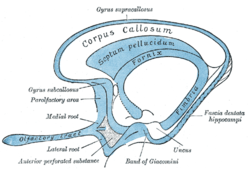Subcallosal area
| Subcallosal area | |
|---|---|
 Scheme of rhinencephalon. (Paraolfactory area labeled at center left.) | |
 Medial surface of left cerebral hemisphere. (Paraolfactory area labeled at center right.) | |
| Details | |
| Identifiers | |
| Latin | area subcallosa, area parolfactoria |
| NeuroNames | 278 |
| NeuroLex ID | birnlex_919 |
| TA98 | A14.1.09.211 |
| TA2 | 5509 |
| FMA | 61890 |
| Anatomical terms of neuroanatomy | |
The subcallosal area (parolfactory area of Broca) is a small triangular field on the medial surface of the hemisphere in front of the subcallosal gyrus, from which it is separated by the posterior parolfactory sulcus; it is continuous below with the olfactory trigone, and above and in front with the cingulate gyrus; it is limited anteriorly by the anterior parolfactory sulcus.
The subcallosal area is also known as "Zuckerkandl's gyrus", for Emil Zuckerkandl.[1]
The parahippocampal gyrus, subcallosal area, and cingulate gyrus have been described together as the periarcheocortex.[2]
The "subcallosal area" and "parolfactory area" are considered equivalent in BrainInfo,[3] but in Terminologia Anatomica they are considered distinct structures.
References
![]() This article incorporates text in the public domain from page 827 of the 20th edition of Gray's Anatomy (1918)
This article incorporates text in the public domain from page 827 of the 20th edition of Gray's Anatomy (1918)
- ^ Shoja MM, Tubbs RS, Loukas M, Shokouhi G, Jerry Oakes W (2008). "Emil Zuckerkandl (1849-1910): anatomist and pathologist". Ann. Anat. 190 (1): 33–6. doi:10.1016/j.aanat.2007.09.001. PMID 18342140.
- ^ Schneider JF, Vergesslich K (April 2007). "Maturation of the limbic system revealed by MR FLAIR imaging" (PDF). Pediatr Radiol. 37 (4): 351–5. doi:10.1007/s00247-007-0415-3. PMID 17325825.
- ^ "BrainInfo". braininfo.rprc.washington.edu.
